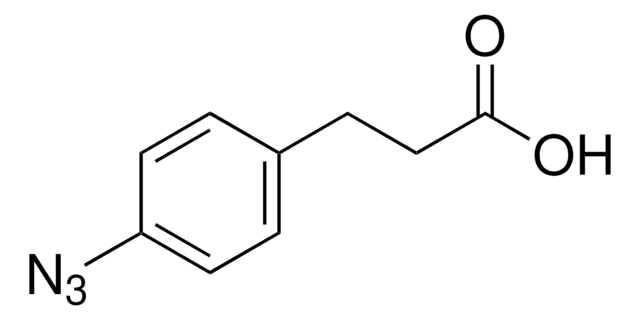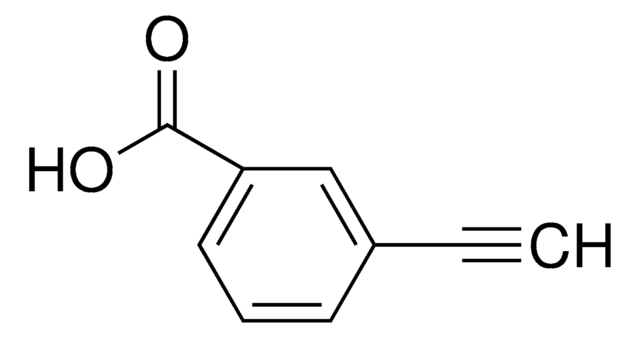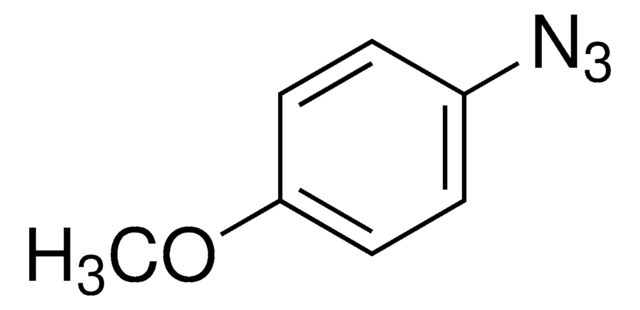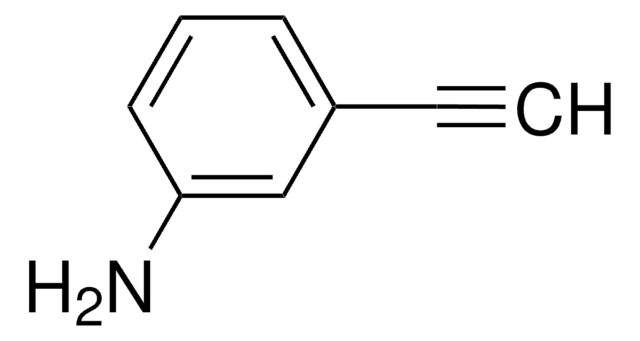778877
4-Azidobenzoic acid solution
~0.2 M in tert-butyl methyl ether, ≥95.0% (HPLC)
Synonym(s):
9-Azidobenzoic acid solution
Sign Into View Organizational & Contract Pricing
All Photos(1)
About This Item
Empirical Formula (Hill Notation):
C7H5N3O2
CAS Number:
Molecular Weight:
163.13
Beilstein:
1950876
MDL number:
UNSPSC Code:
12352106
PubChem Substance ID:
NACRES:
NA.22
Recommended Products
Quality Level
Assay
≥95.0% (HPLC)
form
liquid
concentration
~0.2 M in tert-butyl methyl ether
impurities
≤2.0% water
storage temp.
2-8°C
SMILES string
OC(C1=CC=C(N=[N+]=[N-])C=C1)=O
InChI
1S/C7H5N3O2/c8-10-9-6-3-1-5(2-4-6)7(11)12/h1-4H,(H,11,12)
InChI key
PQXPAFTXDVNANI-UHFFFAOYSA-N
General description
4-Azidobenzoic acid is an aromatic azide generally used in copper(I)-catalyzed azide-alkyne cycloaddition reactions.
Application
Review
Signal Word
Danger
Hazard Statements
Precautionary Statements
Hazard Classifications
Flam. Liq. 2 - Skin Irrit. 2 - STOT RE 2
Target Organs
Blood
Storage Class Code
3 - Flammable liquids
WGK
WGK 3
Choose from one of the most recent versions:
Already Own This Product?
Find documentation for the products that you have recently purchased in the Document Library.
Kai Ling et al.
Journal of biomedical materials research. Part A, 87(1), 52-61 (2007-12-15)
Hydroxypropyl chitosan (HPCS), a water-soluble chitosan derivate, was modified by introducing photoreactive azide groups (4-azidobenzoic acid, Az-) to the amino groups of HPCS, resulting in a photocrosslinkable Az-HPCS. Novel porous chitosan scaffolds thus were fabricated by ultraviolet (UV) light irradiation
P Romero et al.
Journal of immunological methods, 171(1), 73-84 (1994-05-02)
A novel procedure is presented describing the induction of antigen-specific cytolytic T lymphocytes (CTL) in vivo, that uses as immunogen syngeneic Concanavalin A stimulated spleen cells expressing H-2Kd (Kd) molecules photocrosslinked with a photoreactive peptide derivative. The Kd restricted Plasmodium
Bao Li et al.
Regenerative biomaterials, 5(3), 159-166 (2018-06-27)
Photo-reactive poly(vinyl alcohol) (PRPVA) was synthesized by introduction of phenyl azido groups into poly(vinyl alcohol) (PVA) and applied for surface modification. PRPVA was grafted onto cell culture plate surface homogeneously or in a micropattern. Human mesenchymal stem cells (hMSCs) cultured
Renxun Chen et al.
Biofouling, 25(6), 517-524 (2009-05-02)
Infection associated with implanted biomaterials is common and costly and such infections are extremely resistant to antibiotics and host defenses. Consequently, there is a need to develop surfaces which resist bacterial adhesion and colonization. The broad spectrum synthetic cationic peptide
Aiping Zhu et al.
Biomaterials, 23(23), 4657-4665 (2002-09-27)
Chitosan (CS) was covalently immobilized onto polylactic acid (PLA) film surface using the photosensitive hetero-bifunctional crosslinking reagent, 4-azidobenzoic acid, which was previously bonded to chitosan by reaction between an acid group of the crosslinking reagent and a free amino group
Our team of scientists has experience in all areas of research including Life Science, Material Science, Chemical Synthesis, Chromatography, Analytical and many others.
Contact Technical Service











